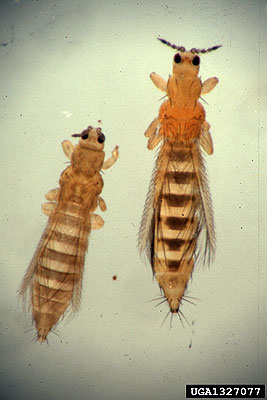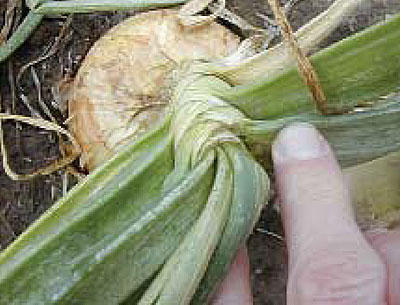 |
| Onion thrips (left) and western flower thrips (right). Alton N. Sparks, Jr., University of Georgia. From https://en.wikipedia.org/wiki/File:Thrips_tabaci,_Frankliniella_occidentalis.jpg |
By Tom Vigue
Before 2002, I had seen the insect called thrips only under a microscope in entomology lab. Then in early July 2002, my onion crop was withering when the bulbs had just begun to size up, about as big as golf balls. On first inspection I had no idea what was going on. Closer inspection, with a hand lens, revealed thrips (Thrips tabaci), which I recognized with disbelief as I had never heard of thrips being a pest insect in Maine, except in greenhouses, and that is a different species.
The insect has been on my farm ever since. If I do nothing about them, they routinely reduce the crop to about a quarter of normal size. What was I to do? The best recommendation I got at the time was to use Pyganic, a strong formulation of pyrethrum, allowed for certified organic farms because it is a botanical.
Botanical it may be, but this broad-spectrum insecticide kills almost any insect that contacts it. I prefer to avoid such strong measures, but I decided to use it on onions because, I reasoned, there is very little insect ecology on onions. Ladybugs, for example, don’t seem to crawl on onion foliage, and onions don’t flower (unless grown a second season for seed production), so bees aren’t present.
So in 2003 I watched carefully for thrips, and when they arrived I was ready with Pyganic. It worked well, and I got an excellent crop.
In 2004 I followed the same routine, watching for thrips and then spraying. By about the third week of July, the crop was withering when the bulbs were about half sized up, and I said, “Now what?”
Close inspection revealed, again, thrips! In vast numbers.
Oh, I said. Oh my. This is what is meant by pesticide resistance.
It turns out that thrips produce as many as five to eight generations per year! And, like aphids, they do so parthenogenically (asexually). Males, in fact, are extremely rare. Any given population of thrips will have a few individuals resistant to whatever insecticide is used, and since females transmit all their genes to their progeny, resistance can build quickly. In places where thrips have traditionally been a serious pest, they have that reputation for resistance.
So, what now?
 |
| Thrips damage on onion. From Onion Thrips (Thrips tabaci) – Utah State University Extension, extension.usu. edu/files/publications/factsheet/ent-117-08pr.pdf |
Around that time a relatively new product, Surround, was becoming more widely known. Surround is finely pulverized kaolin clay. Suspended in water and sprayed on plants, it creates a coating that, surprisingly, actually benefits plants, sometimes enhancing photosynthesis. But the coating is decidedly detrimental to insects pests, as the extremely tiny particles of Surround get on insects’ bodies, causing excess grooming, interfering with mating (not an issue for thrips), interfering with recognition of food sources, and generally annoying and disrupting insects’ habits.
On a hunch, I tried Surround on onions, it worked well, and I have depended on it successfully for eight seasons.
Given the shape of onion leaves and their waxy coating, a spreader/sticker is needed in the spray solution to get Surround to actually coat and stay on leaves. Also, unlike broadleaved plants that grow from their tips, onion leaves elongate from the base. The day after I spray Surround, a bright green band of new growth appears just above the bulb, so I repeat applications every five to seven days until growth slows. This has been a very effective solution – and short of evolving a bristle-brush mustache with which to sweep away annoying particles, thrips should be unable to develop resistance to this product since it doesn’t kill them.
Recognizing and Finding Thrips
Incidentally, the word thrips is both singular and plural. Even a single one is a thrips. Of course, having a separate word for just one would be pointless, since there is never just one.
These are very tiny insects. Adults are yellow to brown, about 1.5 mm long, about 0.3 mm wide, with fringed (hairy) wings.
Larval thrips are 0.5 to 1.0 mm long and so slender as to be barely visible. They are pale whitish to shades of yellow.
Onion leaves are crowded tightly together at their bases, just above the bulb – or, before bulbing commences, just above the soil surface. Parting the leaves just enough to look between them will reveal thrips if any are present (and if your eyes are good enough). At first thrips look like pollen grains, but if you watch them for a few seconds you can see them move.
Recognizing Thrips Injury
Thrips’ mouthparts are adapted for stabbing the epidermal layer of the leaf and then sucking up the exuding juices. (You can imagine how a coating of Surround would interfere with this adaptation.) The damaged epidermis then dries up. Heavily damaged foliage appears to be covered with pale silvery patches and streaks. Left unchecked, the damage soon covers much of the leaf surface, causing leaves to wither and dry, and killing plants prematurely.
Relationship Between Thrips and Diseases
Thrips can carry viral diseases. I have not encountered this yet and hope I never will. Fungal diseases are another story. Thrips do not directly vector fungi, but fungal diseases often follow thrips’ feeding damage opportunistically. At Kiwi Hill Farm, we have purple blotch (Alternaria porri), a deadly onion disease. If thrips damage is unchecked, purple blotch arrives much sooner and becomes rampant much faster. Controlling thrips damage significantly delays the onset and eventual severity of purple blotch.
Thrips Ecology
Thrips’ adults live for about one month, feed (on many plant hosts), and, for about three weeks, lay eggs beneath the leaf epidermis, well protected from poisons and predators. Eggs hatch in five to 10 days. Two actively feeding larval stages last 10 to 14 days and are followed by a third larval stage, whose only purpose is to find an appropriate place to pupate, beneath bulb scales on nearly mature plants or in the soil at the base of younger plants. Mulch reputedly interferes with the latter. The third stage plus pupation lasts five to 10 days.
Adults overwinter in plant debris and in fields. If you cure onions in a greenhouse, don’t start onion seedlings there. I made that mistake once, and the seedlings had thrips on them at planting time.
Predators include green lacewings and minute pirate bugs. I have green lacewings in my garden, but I’ve never seen them on the onions. A cover crop of crimson clover can encourage minute pirate bug populations.
References
Drost, Diane G. and Daniel, Utah State University, Onion Thrips fact sheet, March 2008;
https://extension.usu.edu/files/publications/factsheet/ENT-117-08PR.pdf
Schwartz, H.F., Colorado State University, Botrytis, Downy Mildew and Purple Botch of Onion fact sheet, May 2011; www.ext.colostate.edu/pubs/crops/02941.html
Sideman, Eric, MOFGA’s Pest Reports (for information about thrips’ arrival and control measures);
www.mofga.org/Default.aspx?tabid=732
www.mofga.org/Publications/PestReports/PestReports2012/tabid/2178/Default.aspx?PageContentID=497

